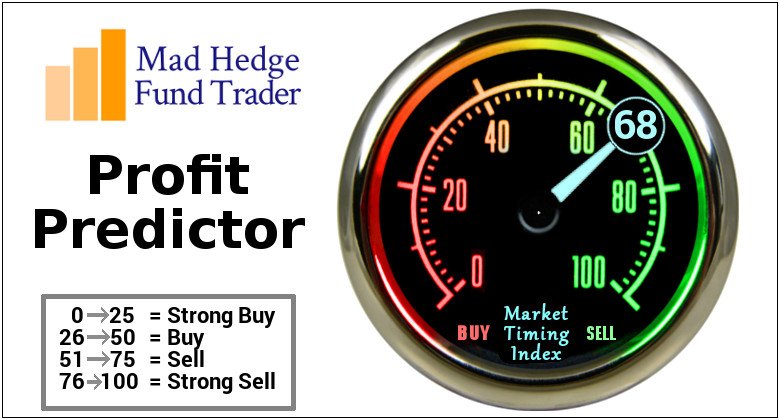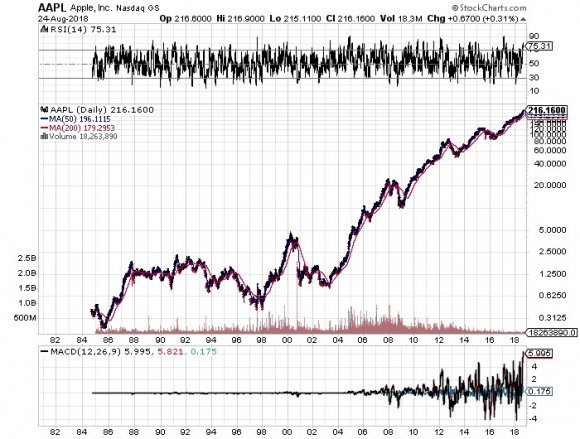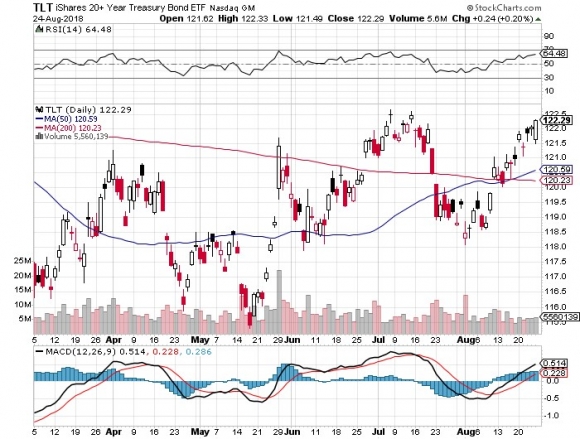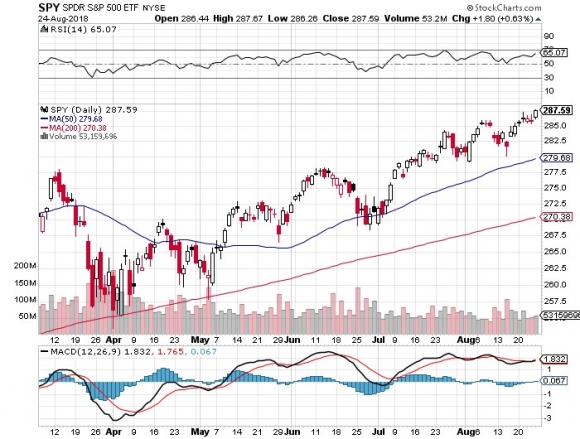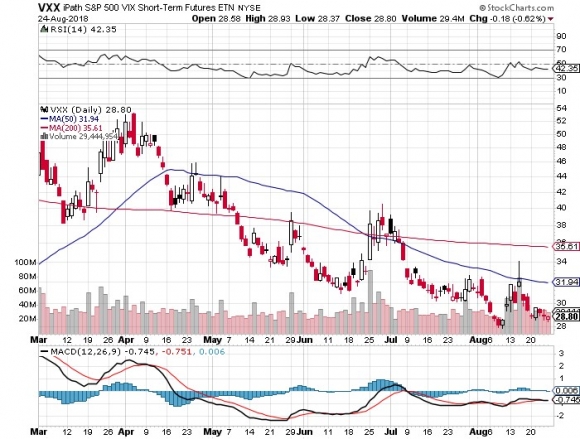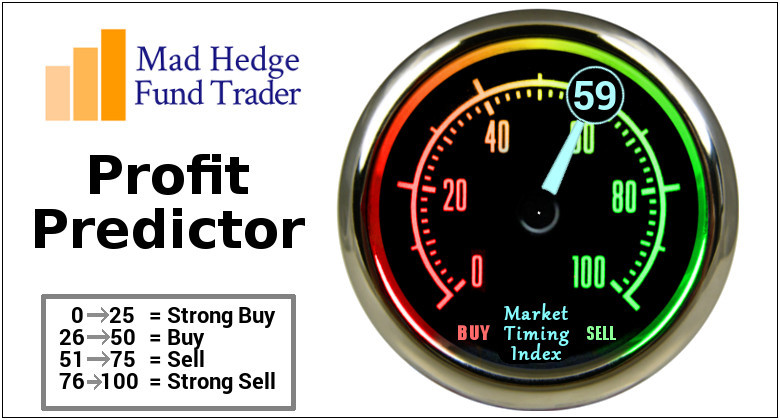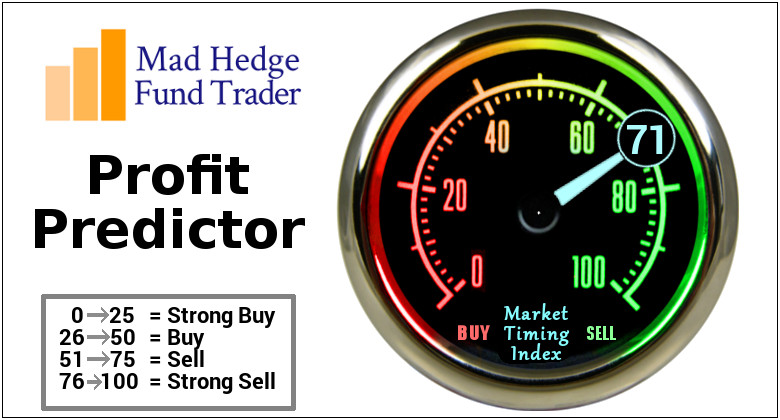Global Market Comments
September 6, 2018
Fiat Lux
Featured Trade:
(TUESDAY, OCTOBER 16, 2018, MIAMI, FL,
GLOBAL STRATEGY LUNCHEON),
(HOW THE RISK PARITY TRADERS ARE RUINING EVERYTHING!),
(VIX), (SPY), (TLT),
(TESTIMONIAL)
Tag Archive for: (SPY)
Global Market Comments
August 27, 2018
Fiat Lux
Featured Trade:
(THE MARKET OUTLOOK FOR THE WEEK AHEAD),
(AAPL), (TLT), (SPY),
(BIDDING MORE FOR THE STARS),
(SPY), (INDU), (AAPL), (AMZN)
Ahhhh…the wonders of global excess liquidity.
Last week saw senior-level felony convictions, the real estate and auto industries rolling over and playing dead, rising inflation, escalating trade wars, sagging exports. It’s as if an entire flock of black swans landed on the markets.
And what did stocks do? Rocket to new all-time highs, Of course! What, are you, some kind of dummy? Didn’t you get the memo? With $50 trillion of global excess liquidity spawned by a decade of quantitative easing, of course stocks will go straight up, forever!
Until they don’t.
Even my favorite, Apple (AAPL) blasted through to new highs at $219 after an analyst raised his target to $245. You may recall me loading the boat with Apple calls during the February meltdown when the shares hit $150.
My target for Apple this year was $200, which I then raised to $220. Am I going to raise my target again? No. As my late mentor, Barton Biggs used to say, “Always leave the last 10% for the next guy.”
It kind of makes my own split adjusted cost of Apple shares of 50 cents, which I picked up in 1998, look pretty good. Yup. That double bottom on the charts at 40 cents said it all.
I used the strength to increase my cash position from 80% to 90%, unloading my long position in Walt Disney options at cost. That leaves me with a single short position in bonds (TLT), which have to see yield on the 10-year U.S. Treasury bond market to fall below 2.67% in three weeks before I lose money.
I am even focusing a sharp eye on the Volatility Index (VIX) for a trade alert this week. If you buy the January 2019 (VXX) $40 calls at $2.90 and the ETF rises 25 points to its April high of $54, these calls would rocket by 382% to $14.00. Sounds like a trade to me! Then I can say thank you very much to Mr. Market, thumb my nose at him, and then take off for the rest of the year. TA-TA!
In the meantime, much of industrial America is getting ready to shut down. Tariffs on 50% of all Chinese imports come into force in September. It turns out that you can’t make anything in the U.S. without the millions of little Chinese parts you’ve never heard of, which also have no U.S. equivalent.
Factories will have to either pass their costs on to consumers in a deflationary economy or shut down. What the administration has done is offset a tax cut with a tax increase in the form of higher import taxes. It was not supposed to work out like that.
The bond rally has pared back my August performance to a dead even at 0.02%. My 2018 year-to-date performance has pulled back to 24.84% and my nine-year return appreciated to 301.31%. The Averaged Annualized Return stands at 34.76%. The more narrowly focused Mad Hedge Technology Fund Trade Alert performance is annualizing now at an impressive 32.24%.
This coming week will be real estate dominated on the data front.
On Monday, August 27, at 10:30 AM EST, we obtain the Dallas Fed Manufacturing Survey.
On Tuesday, August 28, at 9:00 AM EST, we get the June S&P CoreLogic Case-Shiller National Home Price Index. Will we start to see the price falls that more current data are already showing?
On Wednesday, August 29, at 10:00 AM EST, we learn July Pending Home Sales, which lately have been weak.
Thursday, August 30, leads with the Weekly Jobless Claims at 8:30 AM EST, which saw a fall of 2,000 last week to 210,000.
On Friday, August 31, at 10:00 AM EST, we get Chicago Purchasing Managers Index for July. Then the Baker Hughes Rig Count is announced at 1:00 PM EST.
As for me, I think I’ll pop over to the Pebble Beach Concours d'Elegance vintage car show this weekend and place a bid on Ferris Bueller’s red 1962 Ferrari GT California. It’s actually a Hollywood custom chassis built around a Ford engine. I can’t afford a real vintage Ferrari GTO, one of which is expected to sell for an eye-popping $60 million this weekend.
Good luck and good trading.
The stock market has turned into the real estate market, where everyone is afraid to sell their shares for fear of being unable to find a replacement. Will it next turn into the Bitcoin market?
Risk assets everywhere are now facing a good news glut.
My 2019 market top target of 28,000 for the Dow Average is rushing forward with reckless abandon.
Today's price action really gives you the feeling of an approaching short-term blow-off market top.
A few years ago, I went to a charity fundraiser at San Francisco's priciest jewelry store, Shreve & Co., where the well-heeled men bid for dates with the local high society beauties, dripping in diamonds and Channel No. 5.
Amply fueled with champagne, I jumped into a spirited bidding war over one of the Bay Area's premier hotties, whom shall remain nameless. Suffice to say, she is now married to a tech titan and has a sports stadium named after her.
Obviously, I didn't work hard enough.
The bids soared to $23,000, $24,000, $25,000.
After all, it was for a good cause. But when it hit $26,000, I suddenly developed a severe case of lockjaw.
Later, the sheepish winner with a severe case of buyer’s remorse came to me and offered his date back to me for $24,000. I said, “No thanks.” He then implored, “$23,000, $22,000, $21,000?"
I passed.
The altitude of the stock market right now reminds me of that evening.
If you rode the S&P 500 (SPX) from 667 to 2,790 and the Dow Average (INDU) from 7,000 to 25,790, why sweat trying to eke out a few more basis points, especially when the risk/reward ratio sucks so badly, as it does now?
Here we are eight months into the year, and my top picks for the year have gone ballistic. Amazon (AMZN) has doubled off its February low of $1,000, and Apple (AAPL) shares have soared from $150 to $217. Today, an analyst raised his forecast to $245.
As my late mentor, Morgan Stanley’s Barton Biggs, always used to tell me, “Always leave the last 10% for the next guy.”
I realize that many of you are not hedge fund managers, and that running a prop desk, mutual fund, 401k, pension fund, or day trading account has its own demands.
But let me quote what my favorite Chinese general, Deng Xiaoping, once told me: "There is a time to fish, and a time to hang your nets out to dry.
You don't have to chase every trade.
At least then I'll have plenty of dry powder for when the window of opportunity reopens for business. So, while I'm mending my nets, I'll be building new lists of trades for you to strap on when the sun, moon, and stars align once again.
What Am I Bid?
Global Market Comments
August 24, 2018
Fiat Lux
Featured Trade:
(AUGUST 22 BIWEEKLY STRATEGY WEBINAR Q&A),
(BIDU), (BABA), (VIX), (EEM), (SPY), (GLD), (GDX), (BITCOIN),
(SQM), (HD), (TBT), (JWN), (AMZN), (USO), (NFLX), (PIN),
(TAKING A BITE OUT OF STEALTH INFLATION)
Below please find subscribers’ Q&A for the Mad Hedge Fund Trader August 22 Global Strategy Webinar with my guest and co-host Bill Davis of the Mad Day Trader.
As usual, every asset class long and short was covered. You are certainly an inquisitive lot, and keep those questions coming!
Q: How do you think the trade talks will resolve?
A: There will be no resolution this next round of trade talks. China has sent only their most hawkish negotiators who believe that China has done nothing wrong, so don’t expect results any time soon.
Also, because of the arrests in Washington, China is more inclined to just wait out Donald Trump, whether that’s 6 months or 6 1/2 years. They believe they have the upper hand now, sensing weakness in Washington, and in any case, many of the American requests are ridiculous.
Trade talks will likely overhang the market for the rest of this year and you don’t want to go running back into those China Tech plays, like Alibaba (BABA) and Baidu (BIDU) too soon. However, they are offering fantastic value at these levels.
Q: Will the Washington political storm bring down the market?
A: No, it won’t. Even in the case of impeachment, all that will happen is the market will stall and go sideways for a while until it’s over. The market went straight up during the Clinton impeachment, but that was during the tail end of the Dotcom Boom.
Q: Is Alibaba oversold here at 177?
A: Absolutely, it is a great buy. There is a double in this stock over the long term. But, be prepared for more volatility until the trade wars end, especially with China, which could be quite some time.
Q: What would you do with the Volatility Index (VIX) now?
A: Buy at 11 and buy more at 10. It’s a great hedge against your existing long portfolio. It’s at $12 right now.
Q: Are the emerging markets (EEM) a place to be again right now or do you see more carnage?
A: I see more carnage. As long as the dollar is strong, U.S. interest rates are rising, and we have trade wars, the worst victims of all of that are emerging markets as you can see in the charts. Anything emerging market, whether you’re looking at the stocks, bonds or currency, has been a disaster.
Q: Is it time to go short or neutral in the S&P 500 (SPY)?
A: Keep a minimal long just so you have some participation if the slow-motion melt-up continues, but that is it. I’m keeping risks to a minimum now. I only really have one position to prove that I’m not dead or retired. If it were up to me I’d be 100% cash right now.
Q: Would you buy Bitcoin here around $6,500?
A: No, I would not. There still is a 50/50 chance that Bitcoin goes to zero. It’s looking more and more like a Ponzi scheme every day. If we do break the $6,000 level again, look for $4,000 very quickly. Overall, there are too many better fish to fry.
Q: Is it time to buy gold (GLD) and gold miners (GDX)?
A: No, as long as the U.S. is raising interest rates, you don’t want to go anywhere near the precious metals. No yield plays do well in the current environment, and gold is part of that.
Q: What do you think about Lithium?
A: Lithium has been dragged down all year, just like the rest of the commodities. You would think that with rising electric car production around the world, and with Tesla building a second Gigafactory in Nevada, there would be a high demand for Lithium.
But, it turns out Lithium is not that rare; it’s actually one of the most common elements in the world. What is rare is cheap labor and the lack of environmental controls in the processing.
However, it’s not a terrible idea to buy a position in Sociedad Química y Minera (SQM), the major Chilean Lithium producer, but only if you have a nice long-term view, like well into next year. (SQM) was an old favorite of mine during the last commodity boom, when we caught a few doubles. (Check our research data base).
Q: How can the U.S. debt be resolved? Or can we continue on indefinitely with this level of debt?
A: Actually, we can go on indefinitely with this level of debt; what we can’t do is keep adding a trillion dollars a year, which the current federal budget is guaranteed to deliver. At some point the government will crowd out private borrowers, including you and me, out of the market, which will eventually cause the next recession.
Q: Time to rotate out of stocks?
A: Not yet; all we have to do is rotate out of one kind of stock into another, i.e. out of technology and into consumer staple and value stocks. We will still get that performance, but remember we are 9.5 years into what is probably a 10-year bull market.
So, keep the positions small, rotate when the sector changes, and you’ll still make money. But, let's face it the S&P 500 isn’t 600 anymore, it’s 2,800 and the pickings are going to get a lot slimmer from here on out. Watch the movie but stay close to the exit to escape the coming flash fire.
Q: What kind of time frame does Amazon (AMZN) double?
A: The only question is whether it happens now or on the other side of the next recession. We can assume five years for sure.
Q: More upside to Home Depot (HD)?
A: Absolutely, yes. The high home prices lead to increases in home remodeling, and now that Orchard Hardware has gone out of business, all that business has gone to Home Depot. Home Depot just went over $204 a couple days ago.
Q: Do you still like India (PIN)?
A: If you want to pick an emerging market to enter, that’s the one. It’s a Hedge Fund favorite and has the largest potential for growth.
Q: What about oil stocks (USO)?
A: You don’t want to touch them at all; they look terrible. Wait for Texas tea to fall to $60 at the very least.
Q: What would you do with Netflix (NFLX)?
A: I would probably start scaling into buy right here. If you held a gun to my head, the one trade I would do now would be a deep in the money call spread in Netflix, now that they’ve had their $100 drop. And I can’t wait to see how the final season of House of Cards ends!
Q: If yields are going up, why are utilities doing so well?
A: Yields are going down right now, for the short term. We’ve backed off from 3.05% all the way to 2.81%; that’s why you’re getting this rally in the yield plays, but I think it will be a very short-lived event.
Q: Do you see retail stocks remaining strong from now through Christmas?
A: I don’t see this as part of the Christmas move going on right now; I think it’s a rotation into laggard plays, and it’s also very stock specific. Stocks like Nordstrom (JWN) and Target (TGT) are doing well, for instance, while others are getting slaughtered. I would be careful with which stocks you get into.
Good luck and good trading
John Thomas
CEO & Publisher
Diary of a Mad Hedge Fund Trader
Global Market Comments
August 10, 2018
Fiat Lux
Featured Trade:
(AUGUST 8 BIWEEKLY STRATEGY WEBINAR Q&A),
(SPY), (TBT), (PIN), (ISRG), (EDIT), (MU), (LRCX), (NVDA),
(FXE), (FXA), (FXY), (BOTZ), (VALE), (TSLA), (AMZN),
(THE DEATH OF THE CAR),
(GM), (F), (TSLA), (GOOG), (AAPL)
Below please find subscribers' Q&A for the Mad Hedge Fund Trader August 8 Global Strategy Webinar with my guest and co-host Bill Davis of the Mad Day Trader.
As usual, every asset class long and short was covered. You are certainly an inquisitive lot, and keep those questions coming!
Q: What should I do about my (SPY) $290-295 put spread?
A: That is fairly close to the money, so it is a high-risk trade. If you feel like carrying a lot of risk, keep it. If you want to sleep better at night, I would get out on the next dip. The market has 100 reasons to go down and two to go up, the possible end of trade wars and continuing excess global liquidity, and the market is focusing on the two for now.
Q: What are your thoughts on the ProShares Ultra Short Treasury Bond Fund (TBT)?
A: Short term, it's a sell. Long term it's a buy. It's possible we could get a breakout in the bond market here, at the 3% yield level. If that happens, you could get another five points quickly in the TBT. J.P. Morgan's Jamie Diamond thinks we could hit a 5% yield in a year. I think that's high but we are definitely headed in that direction.
Q: What are your thoughts on the India ETF (PIN)?
A: It goes higher. It's been the best-performing emerging market, and a major hedge fund long for the last five years. The basic story is that India is the next China. Indicia is the next big infrastructure build-out. Once India gets regulatory issues out of the way, look for more continued performance.
Q: What are your thoughts on Intuitive Surgical (ISRG)?
A: Intuitive is a kind of microcosm in the market right now. It's trading well above a significant support level, which happens to be $508. I don't typically like Intuitive Surgical stock because the options are very inefficient, and therefore very pricey. I think, at this point, there is a bigger possibility of it breaking down than continuing to head higher. In other words, it's overbought. Buy long term, the sector has a giant tailwind behind it with 80 million retiring baby boomers.
Q: What are your thoughts on the entire chip sector, including Micron (MU), Lam Research (LRCX) and NVIDIA (NVDA)?
A: NVIDIA is the top of the value chain in the entire sector, and it looks like it wants to break to a new high. My target is $300 by the end of the year, from the current $240s. I think the same will happen with Lam Research (LRCX), which just had a massive rally. All three of these have major China businesses; China buys 80% of its chips from the U.S. You can do these in order in the value chain; the lowest value-added company is Micron, followed by Lam Research, followed by NVIDIA, and the performance reflects all of that. So, I think until we get out of the trade wars, Micron will be mired down here. Once it ends, look for it to get a very sharp upside move. Lam is already starting to make its move and so is NVIDIA. Long term, Lam and NVIDIA have doubles in them, so it's not a bad place to buy right here.
Q: You once recommended the Global X Robotics & Artificial Intelligence Thematic ETF (BOTZ) which is now down 10%, one of your few misses. Keep or sell?
A: Keep. It's had the same correction as the rest of Technology. All corrections in Technology are short term in nature--the long-term bull story is still there. (BOTZ) is a huge play on artificial intelligence and automation, so that is going to be with us for a long time, it's just enduring a temporary short-term correction right now, and I would keep it.
Q: What do you have to say about the CRISPR stocks like Editas Medicine Inc. (EDIT)?
A: The whole sector got slammed by a single report that said CRISPR causes cancer, which is complete nonsense. So, I would use this sell-off to increase your current positions. I certainly wouldn't be selling down here.
Q: What could soften the strong dollar?
A: Only one thing: a recession in the U.S. and an end to the interest-raising cycle, which is at least a year off, maybe two. Keep buying the U.S. dollar and selling the currencies (FXE), (FXY), (FXA) until then.
Q: What are your thoughts on Baidu and Alibaba?
A: I thought China tech would get dragged down by the trade wars, but they behaved just as well as our tech companies, so I'd be buying them on dips here. Again, if we do win the trade wars, these Chinese tech companies could rocket. The fundamental stories for all of them is fantastic anyway, so it's a good long-term hold.
Q: Have you looked at Companhia Vale do Rio Doce (VALE)? (A major iron ore producer)
A: No, I've kind of ignored commodities all this year, because it's such a terrible place to be. If we had a red-hot economy, globally you would want to own commodities, but as long as the recovery now is limited to only the U.S., it's not enough to keep the commodity space going. So, I would take your profits up here.
Q: With Tesla (TSLA) up $100 in two weeks should I sell?
A: Absolute. If the $420 buyout goes through you have $40 of upside. If it doesn't, you have $140 of downside. It's a risk/reward that drives like a Ford Pinto.
Q: How long will it take global QE (quantitative easing) to unwind?
A: At least 10 years. While we ended our QE four years ago, Europe and Japan are still continuing theirs. That's why stocks keep going up and bonds won't go down. There is too much cash in the world to sell anything.
Q: Apple (AAPL)won the race to be the first $1 trillion company. Who will win the race to be the first $2 trillion company?
A: No doubt it is will be Amazon (AMZN). It has a half dozen major sectors that are growing gangbusters, like Amazon Web Services. Food and health care are big targets going forward. They could also buy one of the big ticket selling companies to get into that business, like Ticketmaster.
Good Luck and Good trading
John Thomas
CEO & Publisher
The Diary of a Mad Hedge Fund Trader
Global Market Comments
July 27, 2018
Fiat Lux
Featured Trade:
(LAST CHANCE TO ATTEND THE FRIDAY, AUGUST 3, 2018,
AMSTERDAM, THE NETHERLANDS GLOBAL STRATEGY DINNER),
(STOCKS TO BUY ON THE OUTBREAK OF TRADE PEACE),
(QQQ), (SPY), (SOYB), (CORN), (WEAT), (CAT),
(DE), (BA), (QCOM), (MU), (LRCX), (CRUS),
(ORIENT EXPRESS PART II, or REPORT FROM VENICE)
So, how will the trade war end? It could be the crucial trading call of 2018.
"That which can't continue, won't," I paraphrase the noted economist Herbert Stein. I think that logic neatly applies to our global trade wars today.
In 1970, some 25% of world GDP was accounted for by international trade. Today it is 52%. Germany has been the powerhouse, with trade growing from 25% to 80%, largely through exploding auto exports. Trade growth in the U.K. has been pitiful as the old colonial ties loosened, improving only from 40% of GDP to 52%.
In the U.S., trade has grown from 10% to 25% of GDP during this time. It is far lower than the rest of the G7 nations because of the massive size of its domestic economy.
Still, placing restraints on 25% of U.S. GDP, or about $5 trillion, is quite a big hit. Think an imminent recession, quite possible a severe one. The $13 billion in subsidies offered the agriculture sector is but a drop in the bucket. It would be like killing off the goose that laid the golden egg.
Trump has a weak hand, which is growing weaker by the day. It is just a matter of time before he folds. Not to do so would entirely wipe out the benefits of the December tax package, yet still leave the U.S. government with $2 trillion in new debt. It is a perfect money destruction machine.
My bet is that Trump will claim victory at some point soon, regardless of what transpires on the negotiation front. Take the trade war away, and stocks will immediately jump 10%. That's what the stock market thinks, with NASDAQ (QQQ) at an all-time high, and the S&P 500 (SPY) just short of one. Stocks are trading over the medium term as if Donald Trump doesn't exist.
Which stocks should you buy when trade peace breaks out? Buy those that have suffered the most. The ags have to be at the top of your list, such as Soybeans (SOYB), Corn (CORN), and Wheat (WEAT), the worst hit. The old industrials such as Caterpillar (CAT), John Deere (DE), and Boeing (BA) also have to be a priority.
In the technology area you have to rotate out of the FANGs and into chip stocks, the worst performers of the sector this year. Perhaps this is what the market is shouting at us with the horrific one-day decline in Facebook (FB) yesterday. China relies on the U.S. for 80% of its chips and all of its high-end graphics cards.
China's canceling of the QUALCOM (QCOM) takeover of its NXP Semiconductors shows to what extent it is willing to retaliate in the tech area. Chip stocks to buy for the rebound should include Micron Technology (MU), Cirrus Logic (CRUS), and Lam Research (LRCX).
Even if the trade war ends tomorrow, business conditions will never be the same. Confidence in American reliability will never completely recover. Sure, Trump will be gone in 2 1/2 years. But what if he is replaced by someone worse? Trading with the United States now incurs a level of political risk not seen since the War of 1812, when Washington burned.
But no trade war is certainly better than a trade war if you are a trader or investor.
Telling the Captain How to Steer the Ship
Legal Disclaimer
There is a very high degree of risk involved in trading. Past results are not indicative of future returns. MadHedgeFundTrader.com and all individuals affiliated with this site assume no responsibilities for your trading and investment results. The indicators, strategies, columns, articles and all other features are for educational purposes only and should not be construed as investment advice. Information for futures trading observations are obtained from sources believed to be reliable, but we do not warrant its completeness or accuracy, or warrant any results from the use of the information. Your use of the trading observations is entirely at your own risk and it is your sole responsibility to evaluate the accuracy, completeness and usefulness of the information. You must assess the risk of any trade with your broker and make your own independent decisions regarding any securities mentioned herein. Affiliates of MadHedgeFundTrader.com may have a position or effect transactions in the securities described herein (or options thereon) and/or otherwise employ trading strategies that may be consistent or inconsistent with the provided strategies.


